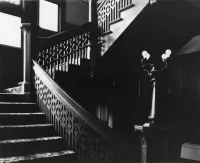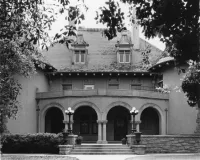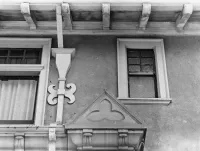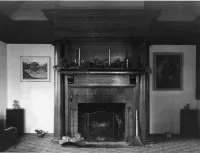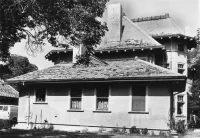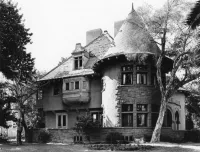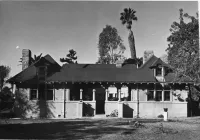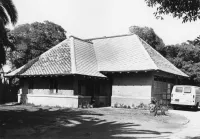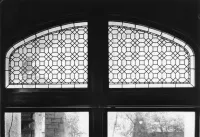Share what you know,
and discover more.
Share what you know,
and discover more.
Jan 23, 1986
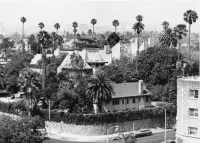
-

- Charmaine Bantugan
Frederick Hastings Rindge House (The Rindge House)- National Register of Historic Places
Statement of Significance The Frederick Hastings Rindge Residence, built in 1902, is one of the finest extant examples of the Châteauesque style constructed in Los Angeles during this period. It is significant for its architectural quality and integrity, its unique sense of time and place, and its virtually unaltered condition. The structure is historically significant as the last residence of Frederick Hastings Rindge, one of Los Angeles' wealthiest and most influential citizens. Before his death in 1905, Mr. Rindge served as director of the Edison Electric Company, vice-president of the Union Oil Company, president of the Conservative Life Insurance Company, president of the Sinaloa Land Company, and owned the extensive Malibu Rancho. The Rindge Residence is a significant example of the work of the noted Southern California architect Frederick Louis Roehrig. The edifice was erected at an estimated cost of $60,000 by master builder E. C. Shipley. Upon completion, the residence was represented in various periodicals of the time, as befitted one of Los Angeles' most elegant mansions. The Rindge Residence is one of the finest extant examples of the Chateauesque style constructed in Los Angeles during this period. It is significant for its architectural quality and integrity, and remains virtually unaltered. Upon completion of its construction in 1902, the structure was recognized as one of the most prestigious residences in Southern California. The residence was well represented in periodicals and pictorials of the time, as befitted one of Los Angeles' most elegant mansions. The structure is prominently situated on a large raised corner lot, and serves as a visually pleasing local landmark. It is compatible in scale and period with neighboring structures in the area originally known as West Adams Heights; one of the most prestigious residential developments in Los Angeles after the turn of the century. The edifice and grounds of the Rindge Residence are an integral component of the remainder of West Adams Heights, visually and architecturally anchoring the historic neighborhood. The Rindge Residence contributes heavily to the unique sense of time and place in Los Angeles created by this neighborhood. The Rindge Residence has been well represented in recent architectural treatments of Los Angeles. The structure is the City of Los Angeles Cultural Historic Landmark No. 95, as determined by the Los Angeles Cultural Heritage Board.^ It was represented in an architectural survey conducted by the Los Angeles County Museum of Natural History in June 1975 under contract from the State Office of Historic Preservation as part of the State Historic Resources Inventory.5 The Rindge Residence was also determined to be eligible for National Register of Historic Places listing by the Community Redevelopment of Los Angeles, the result of an architectural survey of the Adams Normandie 4321 area completed in November 1981it has also been determined eligible for individual National Register listing under the Tax Certification process. The Rindge Residence was the first structure to undergo construction in the prestigious West Adams Heights development. The West Adams Heights Tract was surveyed at the request of Mrs. Mary Moore, George Cochran, A. J. Wallace, and the Associated Trust and Investment Co. The tract was recorded on June 18, 1902.7 Building contracts regarding construction of the residence were drawn on May 17, 1902 by the owner, Frederick Hastings Rindge. ^ The prominent architect F. L. Roehrig of Pasadena had been commissioned to design the residence. Master builder E. C. Shipley was contracted to construct the edifice at a cost of $36,639. Thomas Foulke was contracted to complete all electrical work by December 1, 1902 at a cost of $710. The firm of Babcock and White was contracted to complete all plumbing in the structure for $3,400 by December 1, 1902. All painting and varnishing would be executed by Charles Ellsperman for the sum of $1,614, also to be completed by December 1, 1902. The total cost of construction was estimated in the Los Angeles Times^ at $60,000. The Rindge family relocated from Santa Monica to this residence soon after its completion. ^^ May K. Rindge, widowed in 1905, continued to reside here until her death in 1941. She was known locally for unsuccessfully trying - for 20 years - to deny the federal government rights of way through her 24,000-acre property in Malibu she was also known as the founder and owner of the Malibu Potteries, nationally known for the high quality of its ceramic art tile. Rhoda R. Adamson, daughter of Frederick and May Rindge, controlled the property from the time of the death of May Rindge in 1941, until the property was donated to the Roman Catholic Church in 1944. Rhoda Rindge, incidentally, was the wife of the founder of Adohr Farms dairy, named in her honor.12 Under Church ownership, the mansion became identified as "Jeanne D’Arcy Hall",13 and was used as a convent and later a maternity home. The structure returned to use as a single-family residence in 1975,1^ when it was purchased by Stanford and A. Marie King of Newport Beach. The Kings died in 1981, leaving the house vacant, used only as a location setting for films and television shows until purchased recently by the present owner. Frederick Hastings Rindge was the only surviving heir in a family of six children to the Rindge fortune of Cambridge, Mass. He was born on December 21, 1857 in Cambridge, the son of Samuel Baker Rindge and Clarissa (Harrington) Rindge. The legacy of the Rindge household had been modest since it first arrived in Massachusetts in 1639. By the time of the death of Samuel Baker Rindge on May 3, 1883, however, the family fortune was estimated at $2,000,000. Frederick Hastings Rindge inherited the family fortune soon after his graduation from Harvard in 1879. During his youth, Mr. Rindge had traveled extensively, spending a great deal of time in Europe, and also visiting California. He moved to California permanently in 1887, living first in Los Angeles, then in Santa Monica after 1891. In 1891, he purchased the Malibu Rancho, extending twenty-five miles along the coast northwesterly from Las Flores Canyon. The ranch house was destroyed by fire in 1903, soon after the Harvard Boulevard residence had been completed. Mr. Rindge contributed mightily to the development of the Los Angeles area. He was one of the early supporters of land reclamation and water power utilization. He was a director of the Edison Electric Company, vice-president of the Union Oil Company, president of the Conservative Life Insurance Company, president of the Sinaloa Land Company, and president of the YMCA. Mr. Rindge was highly regarded among citizens in Los Angeles and Cambridge as a generous benefactor and philanthropist. Throughout his lifetime, Mr. Rindge was an enthusiast of California history, lore, and anthropology. His private collection of archeological materials was considered one of the finest in California. His love of California is evident throughout the Harvard Boulevard residence, highlighted by quotations carved in wood, painted inscriptions, and wood carvings of California flora. Frederick Hastings Rindge died in Yreka, California on August 29, 1905, and was interred at the Rosedale Cemetery in Los Angeles on August .15,16,17. Frederick Louis Roehrig was regarded as one of the most prominent residential architects in Southern California during the first two decades of this century. Mr. Roehrig studied architecture at Cornell University, receiving his degree in 1883. He furthered his studies in England and France the year following his graduation. Mr. Roehrig then opened an office in Pasadena, practicing in that city until relocating his offices to Los Angeles in 1890.In 1907 he was elected the secretary and treasurer of the southern district of the State Board of Architecture. Roehrig received commissions to design several prestigious residences in Pasadena, including those for: W, C. Price in 1904;20 John B. Miller in 1905;21 Louise B. Hugus in 1908;22 and Elizabeth G. Reighard on Bellevue Drive in 1913.23 Roehrig was also the architect for the J. L. Giroux Residence^^ in Hollywood about 1912, the William H. Bartlett, Sr. Residence's near Santa Barbara in 1911, the Pasadena Hospital nurse's home26 in 1914, and the Alhambra Public Library.27 Mr. Roehrig also designed utilitarian structures such as the San Francis Quito Canon powerhouses in 1912 for the Aqueduct Advisory Board, the power and light substation at 1636 St. John St.29 in 1916, DWP substation No. 9 at 926 Francisco St.^^ in Los Angeles, and the DWP distributing station at 911 Lincoln Boulevard.31 The Rindge Residence is one of the finest surviving examples of the work of this highly regarded architect.
Frederick Hastings Rindge House (The Rindge House)- National Register of Historic Places
Statement of Significance The Frederick Hastings Rindge Residence, built in 1902, is one of the finest extant examples of the Châteauesque style constructed in Los Angeles during this period. It is significant for its architectural quality and integrity, its unique sense of time and place, and its virtually unaltered condition. The structure is historically significant as the last residence of Frederick Hastings Rindge, one of Los Angeles' wealthiest and most influential citizens. Before his death in 1905, Mr. Rindge served as director of the Edison Electric Company, vice-president of the Union Oil Company, president of the Conservative Life Insurance Company, president of the Sinaloa Land Company, and owned the extensive Malibu Rancho. The Rindge Residence is a significant example of the work of the noted Southern California architect Frederick Louis Roehrig. The edifice was erected at an estimated cost of $60,000 by master builder E. C. Shipley. Upon completion, the residence was represented in various periodicals of the time, as befitted one of Los Angeles' most elegant mansions. The Rindge Residence is one of the finest extant examples of the Chateauesque style constructed in Los Angeles during this period. It is significant for its architectural quality and integrity, and remains virtually unaltered. Upon completion of its construction in 1902, the structure was recognized as one of the most prestigious residences in Southern California. The residence was well represented in periodicals and pictorials of the time, as befitted one of Los Angeles' most elegant mansions. The structure is prominently situated on a large raised corner lot, and serves as a visually pleasing local landmark. It is compatible in scale and period with neighboring structures in the area originally known as West Adams Heights; one of the most prestigious residential developments in Los Angeles after the turn of the century. The edifice and grounds of the Rindge Residence are an integral component of the remainder of West Adams Heights, visually and architecturally anchoring the historic neighborhood. The Rindge Residence contributes heavily to the unique sense of time and place in Los Angeles created by this neighborhood. The Rindge Residence has been well represented in recent architectural treatments of Los Angeles. The structure is the City of Los Angeles Cultural Historic Landmark No. 95, as determined by the Los Angeles Cultural Heritage Board.^ It was represented in an architectural survey conducted by the Los Angeles County Museum of Natural History in June 1975 under contract from the State Office of Historic Preservation as part of the State Historic Resources Inventory.5 The Rindge Residence was also determined to be eligible for National Register of Historic Places listing by the Community Redevelopment of Los Angeles, the result of an architectural survey of the Adams Normandie 4321 area completed in November 1981it has also been determined eligible for individual National Register listing under the Tax Certification process. The Rindge Residence was the first structure to undergo construction in the prestigious West Adams Heights development. The West Adams Heights Tract was surveyed at the request of Mrs. Mary Moore, George Cochran, A. J. Wallace, and the Associated Trust and Investment Co. The tract was recorded on June 18, 1902.7 Building contracts regarding construction of the residence were drawn on May 17, 1902 by the owner, Frederick Hastings Rindge. ^ The prominent architect F. L. Roehrig of Pasadena had been commissioned to design the residence. Master builder E. C. Shipley was contracted to construct the edifice at a cost of $36,639. Thomas Foulke was contracted to complete all electrical work by December 1, 1902 at a cost of $710. The firm of Babcock and White was contracted to complete all plumbing in the structure for $3,400 by December 1, 1902. All painting and varnishing would be executed by Charles Ellsperman for the sum of $1,614, also to be completed by December 1, 1902. The total cost of construction was estimated in the Los Angeles Times^ at $60,000. The Rindge family relocated from Santa Monica to this residence soon after its completion. ^^ May K. Rindge, widowed in 1905, continued to reside here until her death in 1941. She was known locally for unsuccessfully trying - for 20 years - to deny the federal government rights of way through her 24,000-acre property in Malibu she was also known as the founder and owner of the Malibu Potteries, nationally known for the high quality of its ceramic art tile. Rhoda R. Adamson, daughter of Frederick and May Rindge, controlled the property from the time of the death of May Rindge in 1941, until the property was donated to the Roman Catholic Church in 1944. Rhoda Rindge, incidentally, was the wife of the founder of Adohr Farms dairy, named in her honor.12 Under Church ownership, the mansion became identified as "Jeanne D’Arcy Hall",13 and was used as a convent and later a maternity home. The structure returned to use as a single-family residence in 1975,1^ when it was purchased by Stanford and A. Marie King of Newport Beach. The Kings died in 1981, leaving the house vacant, used only as a location setting for films and television shows until purchased recently by the present owner. Frederick Hastings Rindge was the only surviving heir in a family of six children to the Rindge fortune of Cambridge, Mass. He was born on December 21, 1857 in Cambridge, the son of Samuel Baker Rindge and Clarissa (Harrington) Rindge. The legacy of the Rindge household had been modest since it first arrived in Massachusetts in 1639. By the time of the death of Samuel Baker Rindge on May 3, 1883, however, the family fortune was estimated at $2,000,000. Frederick Hastings Rindge inherited the family fortune soon after his graduation from Harvard in 1879. During his youth, Mr. Rindge had traveled extensively, spending a great deal of time in Europe, and also visiting California. He moved to California permanently in 1887, living first in Los Angeles, then in Santa Monica after 1891. In 1891, he purchased the Malibu Rancho, extending twenty-five miles along the coast northwesterly from Las Flores Canyon. The ranch house was destroyed by fire in 1903, soon after the Harvard Boulevard residence had been completed. Mr. Rindge contributed mightily to the development of the Los Angeles area. He was one of the early supporters of land reclamation and water power utilization. He was a director of the Edison Electric Company, vice-president of the Union Oil Company, president of the Conservative Life Insurance Company, president of the Sinaloa Land Company, and president of the YMCA. Mr. Rindge was highly regarded among citizens in Los Angeles and Cambridge as a generous benefactor and philanthropist. Throughout his lifetime, Mr. Rindge was an enthusiast of California history, lore, and anthropology. His private collection of archeological materials was considered one of the finest in California. His love of California is evident throughout the Harvard Boulevard residence, highlighted by quotations carved in wood, painted inscriptions, and wood carvings of California flora. Frederick Hastings Rindge died in Yreka, California on August 29, 1905, and was interred at the Rosedale Cemetery in Los Angeles on August .15,16,17. Frederick Louis Roehrig was regarded as one of the most prominent residential architects in Southern California during the first two decades of this century. Mr. Roehrig studied architecture at Cornell University, receiving his degree in 1883. He furthered his studies in England and France the year following his graduation. Mr. Roehrig then opened an office in Pasadena, practicing in that city until relocating his offices to Los Angeles in 1890.In 1907 he was elected the secretary and treasurer of the southern district of the State Board of Architecture. Roehrig received commissions to design several prestigious residences in Pasadena, including those for: W, C. Price in 1904;20 John B. Miller in 1905;21 Louise B. Hugus in 1908;22 and Elizabeth G. Reighard on Bellevue Drive in 1913.23 Roehrig was also the architect for the J. L. Giroux Residence^^ in Hollywood about 1912, the William H. Bartlett, Sr. Residence's near Santa Barbara in 1911, the Pasadena Hospital nurse's home26 in 1914, and the Alhambra Public Library.27 Mr. Roehrig also designed utilitarian structures such as the San Francis Quito Canon powerhouses in 1912 for the Aqueduct Advisory Board, the power and light substation at 1636 St. John St.29 in 1916, DWP substation No. 9 at 926 Francisco St.^^ in Los Angeles, and the DWP distributing station at 911 Lincoln Boulevard.31 The Rindge Residence is one of the finest surviving examples of the work of this highly regarded architect.
Jan 23, 1986
Frederick Hastings Rindge House (The Rindge House)- National Register of Historic Places
Statement of SignificanceThe Frederick Hastings Rindge Residence, built in 1902, is one of the finest extant examples of the Châteauesque style constructed in Los Angeles during this period. It is significant for its architectural quality and integrity, its unique sense of time and place, and its virtually unaltered condition. The structure is historically significant as the last residence of Frederick Hastings Rindge, one of Los Angeles' wealthiest and most influential citizens. Before his death in 1905, Mr. Rindge served as director of the Edison Electric Company, vice-president of the Union Oil Company, president of the Conservative Life Insurance Company, president of the Sinaloa Land Company, and owned the extensive Malibu Rancho. The Rindge Residence is a significant example of the work of the noted Southern California architect Frederick Louis Roehrig. The edifice was erected at an estimated cost of $60,000 by master builder E. C. Shipley. Upon completion, the residence was represented in various periodicals of the time, as befitted one of Los Angeles' most elegant mansions.
The Rindge Residence is one of the finest extant examples of the Chateauesque style constructed in Los Angeles during this period. It is significant for its architectural quality and integrity, and remains virtually unaltered. Upon completion of its construction in 1902, the structure was recognized as one of the most prestigious residences in Southern California. The residence was well represented in periodicals and pictorials of the time, as befitted one of Los Angeles' most elegant mansions. The structure is prominently situated on a large raised corner lot, and serves as a visually pleasing local landmark. It is compatible in scale and period with neighboring structures in the area originally known as West Adams Heights; one of the most prestigious residential developments in Los Angeles after the turn of the century. The edifice and grounds of the Rindge Residence are an integral component of the remainder of West Adams Heights, visually and architecturally anchoring the historic neighborhood. The Rindge Residence contributes heavily to the unique sense of time and place in Los Angeles created by this neighborhood.
The Rindge Residence has been well represented in recent architectural treatments of Los Angeles. The structure is the City of Los Angeles Cultural Historic Landmark No. 95, as determined by the Los Angeles Cultural Heritage Board.^ It was represented in an architectural survey conducted by the Los Angeles County Museum of Natural History in June 1975 under contract from the State Office of Historic Preservation as part of the State Historic Resources Inventory.5 The Rindge Residence was also determined to be eligible for National Register of Historic Places listing by the Community Redevelopment of Los Angeles, the result of an architectural survey of the Adams Normandie 4321 area completed in November 1981it has also been determined eligible for individual National Register listing under the Tax Certification process.
The Rindge Residence was the first structure to undergo construction in the prestigious West Adams Heights development. The West Adams Heights Tract was surveyed at the request of Mrs. Mary Moore, George Cochran, A. J. Wallace, and the Associated Trust and Investment Co. The tract was recorded on June 18, 1902.7 Building contracts regarding construction of the residence were drawn on May 17, 1902 by the owner, Frederick Hastings Rindge. ^ The prominent architect F. L. Roehrig of Pasadena had been commissioned to design the residence. Master builder E. C. Shipley was contracted to construct the edifice at a cost of $36,639. Thomas Foulke was contracted to complete all electrical work by December 1, 1902 at a cost of $710. The firm of Babcock and White was contracted to complete all plumbing in the structure for $3,400 by December 1, 1902. All painting and varnishing would be executed by Charles Ellsperman for the sum of $1,614, also to be completed by December 1, 1902. The total cost of construction was estimated in the Los Angeles Times^ at $60,000. The Rindge family relocated from Santa Monica to this residence soon after its completion. ^^ May K. Rindge, widowed in 1905, continued to reside here until her death in 1941. She was known locally for unsuccessfully trying - for 20 years - to deny the federal government rights of way through her 24,000-acre property in Malibu she was also known as the founder and owner of the Malibu Potteries, nationally known for the high quality of its ceramic art tile. Rhoda R. Adamson, daughter of Frederick and May Rindge, controlled the property from the time of the death of May Rindge in 1941, until the property was donated to the Roman Catholic Church in 1944. Rhoda Rindge, incidentally, was the wife of the founder of Adohr Farms dairy, named in her honor.12 Under Church ownership, the mansion became identified as "Jeanne D’Arcy Hall",13 and was used as a convent and later a maternity home. The structure returned to use as a single-family residence in 1975,1^ when it was purchased by Stanford and A. Marie King of Newport Beach. The Kings died in 1981, leaving the house vacant, used only as a location setting for films and television shows until purchased recently by the present owner.
Frederick Hastings Rindge was the only surviving heir in a family of six children to the Rindge fortune of Cambridge, Mass. He was born on December 21, 1857 in Cambridge, the son of Samuel Baker Rindge and Clarissa (Harrington) Rindge. The legacy of the Rindge household had been modest since it first arrived in Massachusetts in 1639. By the time of the death of Samuel Baker Rindge on May 3, 1883, however, the family fortune was estimated at $2,000,000.
Frederick Hastings Rindge inherited the family fortune soon after his graduation from Harvard in 1879. During his youth, Mr. Rindge had traveled extensively, spending a great deal of time in Europe, and also visiting California. He moved to California permanently in 1887, living first in Los Angeles, then in Santa Monica after 1891. In 1891, he purchased the Malibu Rancho, extending twenty-five miles along the coast northwesterly from Las Flores Canyon. The ranch house was destroyed by fire in 1903, soon after the Harvard Boulevard residence had been completed. Mr. Rindge contributed mightily to the development of the Los Angeles area. He was one of the early supporters of land reclamation and water power utilization. He was a director of the Edison Electric Company, vice-president of the Union Oil Company, president of the Conservative Life Insurance Company, president of the Sinaloa Land Company, and president of the YMCA. Mr. Rindge was highly regarded among citizens in Los Angeles and Cambridge as a generous benefactor and philanthropist. Throughout his lifetime, Mr. Rindge was an enthusiast of California history, lore, and anthropology. His private collection of archeological materials was considered one of the finest in California. His love of California is evident throughout the Harvard Boulevard residence, highlighted by quotations carved in wood, painted inscriptions, and wood carvings of California flora. Frederick Hastings Rindge died in Yreka, California on August 29, 1905, and was interred at the Rosedale Cemetery in Los Angeles on August .15,16,17.
Frederick Louis Roehrig was regarded as one of the most prominent residential architects in Southern California during the first two decades of this century. Mr. Roehrig studied architecture at Cornell University, receiving his degree in 1883. He furthered his studies in England and France the year following his graduation. Mr. Roehrig then opened an office in Pasadena, practicing in that city until relocating his offices to Los Angeles in 1890.In 1907 he was elected the secretary and treasurer of the southern district of the State Board of Architecture. Roehrig received commissions to design several prestigious residences in Pasadena, including those for: W, C. Price in 1904;20 John B. Miller in 1905;21 Louise B. Hugus in 1908;22 and Elizabeth G. Reighard on Bellevue Drive in 1913.23 Roehrig was also the architect for the J. L. Giroux Residence^^ in Hollywood about 1912, the William H. Bartlett, Sr. Residence's near Santa Barbara in 1911, the Pasadena Hospital nurse's home26 in 1914, and the Alhambra Public Library.27 Mr. Roehrig also designed utilitarian structures such as the San Francis Quito Canon powerhouses in 1912 for the Aqueduct Advisory Board, the power and light substation at 1636 St. John St.29 in 1916, DWP substation No. 9 at 926 Francisco St.^^ in Los Angeles, and the DWP distributing station at 911 Lincoln Boulevard.31 The Rindge Residence is one of the finest surviving examples of the work of this highly regarded architect.
Posted Date
Mar 22, 2022
Historical Record Date
Jan 23, 1986
Source Name
United States Department of Interior - National Park Service
Source Website
Delete Story
Are you sure you want to delete this story?


